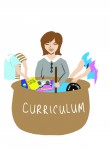When the professor in my comparative literature class asks, “Does anyone have any questions about the syllabus?” no one raises their hand to suggest additional readings, supplemental films or essays.
Generally, students are not engaged with their texts, their professor or their peers until the first day of class. Even then, they are not expected to give input on chosen course material.
But Michael Ryan, a visiting assistant professor of Germanic languages and literature at Duke University, recently taught a course called “Humanities on Demand: Narrative Gone Viral,” which challenged those notions.
Ryan asked 6,500 students to submit ideas for course materials for the class, calling his interactive approach “Epic Course Design.” Ryan describes his experience soliciting students’ input for the syllabus in the article “Crowdsourcing the Curriculum,” published by Inside Higher Ed.
Of course, Ryan’s is not a typical humanities course and most do not require texts from popular culture, but this model could work at UCLA in several ways to increase students’ investment in their classes.
In Narrative Gone Viral, Ryan and his students examined student-selected YouTube videos for their humanistic and narrative potentials.
Ryan’s model provided a way for students to actively engage with course material before the course began. And by the time it did, students already knew what to expect and had a vested interest in those materials, he said.
Currently, professors and teaching assistants devise syllabi based on department standards or past courses. Students who enroll in classes can see those syllabi before the quarter begins, due to technology implemented by the Common Collaboration and Learning Environment website in November. But once the quarter begins, students and professors alike adhere to that syllabus as closely as possible for the next 10 weeks.
However, not all professors adhere strictly to their syllabi. English professor Stephen Dickey said he already implements student suggestions during the quarter, giving students choices on homework assignments and texts.
Professors could add a discussion forum to the online syllabi that students could interact with, marking what they have and have not already read, and suggesting texts, articles about texts or supplementary films. Professors could see student responses and students could see each other’s responses.
Of course, students can choose to do this now by emailing their professors and suggesting readings. But that interaction generally does not spark a thread of engagement between students or with the class as a whole.
Implementing a practice like this could raise students’ consciousness of their education as something that they are able to guide. But there could also be greater implications for allowing students to have a say in what they read and discuss.
Shawn Zhang, a second-year English student, said he felt this sort of interaction could be productive, although professors should ultimately have the freedom to design their classes.
English students will always read Shakespeare, but allowing them to suggest texts outside of the canon could diversify departmental learning and challenge the notion that certain texts must be read for a student to be considered well educated.
Ryan said that in his experience, the crowdsourcing model increased class participation in a traditional sense, while also broadening the definition of participation. Even students not enrolled in the class had the opportunity to submit materials, he said.
An online forum would be a simple tool, and all it would require is a little time and effort to put in place, but it could help give students a hand in crafting their own education experiences, something that is difficult to do when a syllabus is just a checklist set in stone by someone else.
